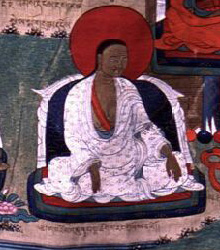Biography and autobiography in Tibet are important sources for both education and inspiration. The authors involved in the Treasury of Lives mine primary sources to provide English-language biographies of every known religious teacher from Tibet and the Himalaya, all of which are organized on their website. The following summarizes the biography of the 1st Adzom Drukpa by Alexander Gardner with Samten Chhosphel.

Dilgo Khyentse Tashi Paljor was a teacher to teachers. Universally respected among every school and lineage of Tibetan Buddhism, his life story has served as an inspiration to many. But even this teacher had a teacher of his own. The subject of today’s Treasury of Lives post documents the life of one of Dilgo Khyentse’s early teachers, the 1st Adzom Drukpa, Drodul Pawo.
Born in Kham, eastern Tibet in 1842 to a family of practitioners, Drodul Pawo was the second son of nine children. Several different teachers from both the Nyingma and Drukpa Kagyu traditions recognized him as a tulku, and although he retained “Drukpa” in his name, he did not focus primarily on the Drukpa Kagyu teachings. He studied treasure (“revealed”) teachings as well as Sakya, Kadam, Zhije, and Chod at both Zhechen and Katok, two major Nyingma monasteries.
At some point, he was advised to remain a layman and to let his hair grow long in the style of a tantric practitioner. During this time, two of his teachers were the luminaries Dza Patrul Orgyen Jigme Chokyi Wangpo (1808–1887), who penned Words of my Perfect Teacher, and Jamyang Khyentse Wangpo (1820–1892), of whom Dilgo Khyentse is considered an incarnation. He also studied with many other prominent teachers of what has come to be characterized as the Rime (“nonsectarian”) period, including Ju Mipam Gyatso (1846–1912) and Jamgon Kongtrul (1813–1899).
In accordance with his responsibilities as a tulku, there came a time when he had to decide whether to repair his predecessor’s monastery, which had been damaged during a civil unrest, or to build a new one altogether. He went into a retreat and is said to have received a message from a dakini, but it was unclear. He offered small repairs to the old monastery and only twenty years later established Adzom Gar in Tromtar, which featured a large shrine hall but mostly existed as an encampment. His son Gyurme Dorje (b.1895) later oversaw the building of more permanent monks’ quarters. Today, it remains one of the largest active monasteries in the region, and includes a printing house, a monastic college, and a large temple.
In 1917 the encampment faced brutal attack and raid by Chaktring forces that viciously damaged the settlement. Afterwards, however, it is said that the commander of the force, Lobzang Tashi, was so impressed by Adzom Drukpa that he became his devotee, returning all the animals and property he had taken and even giving compensation to the individuals that had been harmed. When the commander apologized for the assault, Adzom Drukpa is said to have responded, “How can we practice patience if there are no enemies? You may kill them if their karma deserves death!”
Adzom Drukpa then went on an extended pilgrimage thought Kham and Amdo, giving teachings to thousands of students. When he returned to Zhechen monastery he came into contact with Dilgo Khyentse’s family, whom he took under his protection, administering novice vows to the young boy (despite Mipham Rinpoche’s advice to the contrary).
It is said that around midnight on the night before he died, people witnessed strange rays of light that did not reflect on surfaces. He passed away around the age of 83, and sat in postmortem meditation with his heart still warm for about ten days. His legacy was continued by his many students, a large number of whom also taught masters still active in the West today.
Thank you for subscribing to Tricycle! As a nonprofit, we depend on readers like you to keep Buddhist teachings and practices widely available.